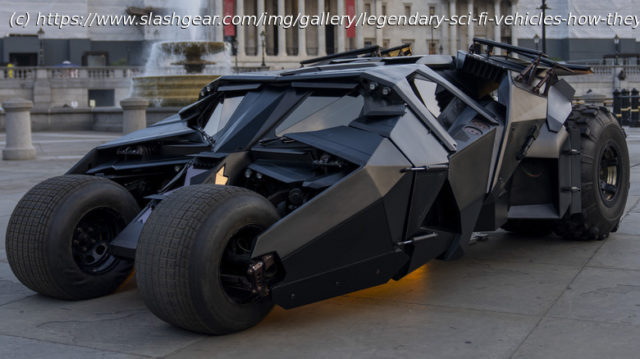There are plenty of memorable movie cars, but how did the film crews bring them to life? Let’s take a look at some iconic vehicles and their production process,
Audiences love to live vicariously through the characters of their favorite stories. Occasionally, individual story beats are the cause, but other times it just comes down to the world itself. Case in point — sci-fi vehicles.
Since science fiction worlds aren’t restricted to the limitations of real-world physics and energy generation, writers are free to go ham and a half on sci-fi vehicle concepts. Odds are you can find at least one design that speaks to you due to aesthetics or capabilities. Maybe it’s Kaneda’s iconic motorcycle from „Akira“, or maybe it’s the TARDIS from „Doctor Who“ in all its blue glory. However, not everyone is aware of how much work goes into constructing these vehicles for the big and small screens — after all, not everything can be built out of computer-generated polygons like the Separatist Armored Assault Tank from „Star Wars: The Phantom Menace.“
If a producer wants a sci-fi vehicle to have a tangible presence and a sense of realism, they have to use a live, physical model. For larger vehicles or when cars and spaceships perform feats of fantastical daring, a miniature is often required, but when the vehicle has to interact with actors or live sets, it is usually built to scale using available parts. Here are 10 iconic sci-fi vehicles and how they were made.Aliens‘ M577 Armored Personnel Carrier
The earlier „Alien“ movies are a masterclass of set and prop design, thanks in no small part to the legendary H.R. Giger and his work conceptualizing the titular aliens. Production value is through the roof in these films, but set designers cut corners wherever possible. For instance, tools hanging from the medical bay ceiling in „Aliens“ are semi-transformed Shockwave Transformers toys. The film crew used a similar recycling trick for the movie’s armored transport.
In „Aliens“, the M577 Armored Personnel Carrier (APC) is a lightweight, low profile troop transport that is designed to safely ferry United States Colonial Marine Corps soldiers from a dropship to their destination. While the APC has enough room for 12 passengers, it is also outfitted with a forward-facing cannon, rotating roof turret, and smart missiles. The M577 isn’t the biggest gun in the „Aliens“ universe, but it still gets the job done.
To bring the M577 to life, filmmakers constructed two APCs. One was a miniature used for action sequences, the other was a life-size roving menace. The original design called for a vehicle with 10-foot diameter wheels, which would have required mining trucks. Instead, the film crew got the next best thing, a Hunslet ATT77 Air Towing Tractor, which had six-foot diameter wheels. A contracted customizer company removed 35 tons of weight from the 75-ton vehicle and converted it inside and out. Also, film crews had to reinforce set floors so the tractors wouldn’t fall through. The rest was movie history.Star Wars: Episode IV A New Hope’s X-34 Landspeeder
A long time ago, in a galaxy far, far away, humans lived in relative peace with alien species and had access to technology far more advanced than anything we currently have. Some pieces of „Star Wars“ tech have become reality — kinda — but others have not, most notably hover cars.
Hover technology is commonplace throughout the Star Wars universe, and one of the first examples we see in „Star Wars: A New Hope“ is Luke Skywalker’s Landspeeder, or to be more specific, his X-34 Landspeeder. While the film starts with an epic battle between spaceships, the Landspeeder demonstrates that advanced technology is readily available to almost anyone, even humble moisture farmers who live in the boonies of a desert planet.
While CGI has been used for more recent portrayals of „Star Wars“ Landspeeders with mixed results, the original rendition relied on a mix of practical effects and movie magic. The X-34 Landspeeder prop was a simple vehicle shell with a balance bar placed around a small, three-wheeler known as the Bond Bug, developed by Ogle Design. To achieve the illusion that the vehicle was hovering during wide shots, the shell sported an angled mirror at the bottom, and a broom was attached to kick up dust. Otherwise, the crew used close up shots to hide the vehicle’s underside. Who could have ever predicted that the trick would still hold up so well several decades later?Batman Begins‘ Tumbler
Some people say Batman doesn’t have superpowers, but he certainly does have superior branding. Every item in his utility belt — figuratively and literally — is instantly recognizable as distinctly Batman. That goes double for his car, the Batmobile. The caped crusader has used countless vehicles throughout his live-action iterations, from the customized 1955 Ford Lincoln Futura seen in the 1960s „Batman“ television show to the iconic 1989 film version made from two Chevrolet Impala chassis. Then there’s the Tumbler.
Introduced in „Batman Begins“, the Tumbler was designed for in-universe military applications but was given a second chance as the Batmobile in everything but name.






